#Marasmiaceae
Photo


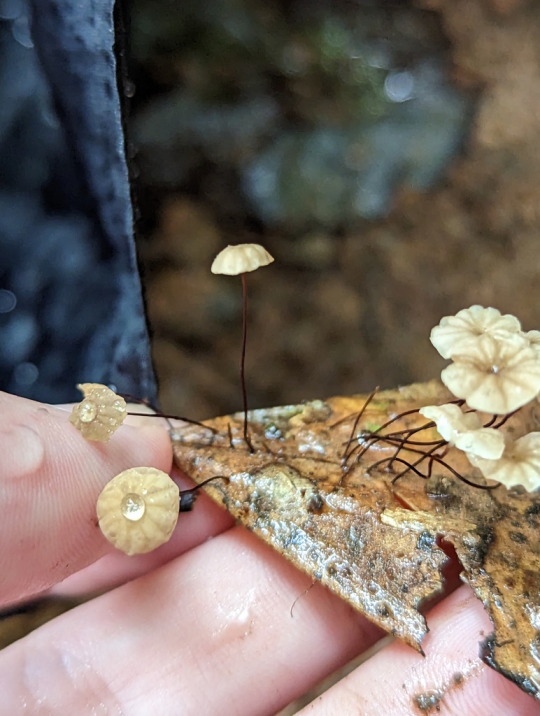
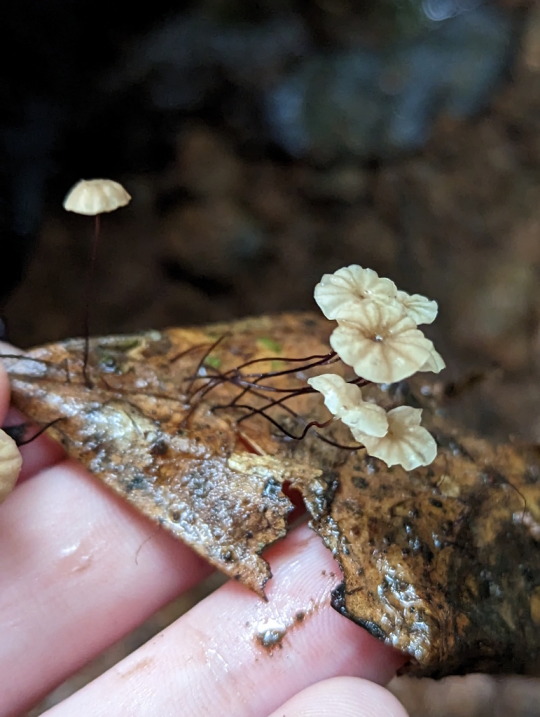
Rainforest Horsehair Mushrooms
Marasmius crinis-equi
22/02/23
#Marasmius crinis-equi#Rainforest Horsehair#Marasmiaceae#pinwheels#Agaricales#Basidiomycota#Basidiomycete Fungi#mushrooms#mushroom#fungi#fungus#mycology
1K notes
·
View notes
Text
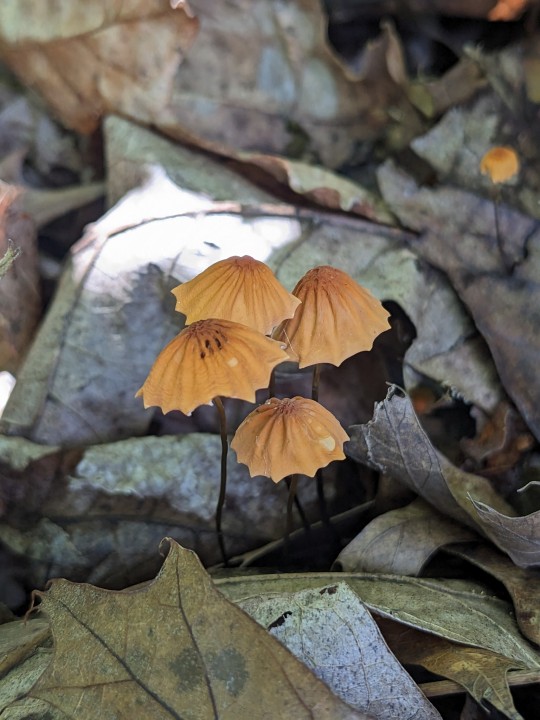
Orange Pinwheel Mushroom Marasmius siccus

This tiny umbrella shaped mushroom species is found in forests from the Rocky Mountains to the Appalachian Mountains.
Aug. 14th, 2023
St. Louis County, Missouri, USA
Olivia R. Myers
@oliviarosaline
#fungi#wild fungi#fungus#mushrooms#mushroom#umbrella mushrooms#mushroom umbrella#parasol mushroom#parasol mushrooms#mycology#nature#beautiful nature#fungi photography#forest floor#tiny mushrooms#small mushrooms#cottagecore#ozarks#the ozarks#Missouri nature#nature core#Marasmiaceae#agaricales#pinwheel mushroom#pinwheel mushrooms
21 notes
·
View notes
Text
FOTD #113 : orange pinwheel! (marasmius siccus)
the orange pinwheel is a mushroom found in the rocky & appalachian mountains, northern europe, & asia. it often grows in hardwood forests !! it belongs to the family marasmiaceae.
the big question : can i bite it??
i suppose..? it is non-poisonous !!



m. siccus description :
"it is a small, orange mushroom with a "beach umbrella"-shaped cap. the tough shiny bare stem is pale at the top but reddish brown below, & the gills are whitish. the stem is 3–7 centimetres (1.2–2.8 in) tall & the cap is 0.5–2.5 centimetres (0.20–0.98 in) wide."
[images : source, source & source]
[fungus description : source]
#• fungus of the day !! •#[marasmius siccus]#: orange pinwheel :#113#||#mycology#mushroom#mushrooms#earth#cottagecore#forestcore#nature#fungi#fungus#foraging#fungus of the day#fotd#marasmius siccus#orange pinwheel
421 notes
·
View notes
Text
Cocoa Products Market - Forecast (2022 - 2027)
Cocoa Products Market size is estimated to reach $30.6 billion by 2027, growing at a CAGR of 3.1% during the forecast period 2022-2027. The cocoa bean or just cocoa also termed the cacao bean or cacao is the dried and completely fermented seed of Theobroma cacao, from which cocoa solids (a mixture of non-fat substances) and cocoa butter (the fat) may be derived. Cocoa powder and cocoa butter are typical cocoa products. Investigations have been conducted which offer a basis for comprehending the molecular basis of fine aroma constituents in cocoa, and thereby for the establishment of molecular markers connected to fine aroma quality in this species. During the last decade, different functional genomics and certain proteomic projects have been commenced, inclusive of expressed sequence tag and BAC libraries building, cacao genome sequencing, expression studies of cacao tissues disputed with the principal pathogens (Moniliophthora perniciosa, Phytophthora spp.), or exposure to other stress conditions like drought, and expression investigations connected to cacao quality flavor. Moniliophthora perniciosa, formerly termed Crinipellis perniciosa (Singer) Stahel, is a hemibiotrophic basidiomycete (Tricholomataceae, Agaricales, Marasmiaceae) fungus that brings about Witches' broom disease (WBD) in cacao (Theobroma cacao L.). Cocoa beans are a well-recognized source of antioxidant polyphenols. Specifically individual oligomeric proanthocyanidins established a compelling contribution to the complete antioxidant activity of cocoa in comparison with monomeric compounds.
The surging utilization of cocoa powder in the production of chocolate confectionaries and cocoa paste is set to drive the Cocoa Products Market. The soaring application of cocoa butter in pharmaceutical and cosmetic industries to produce skincare products in conjunction with cacao molecular studies involving molecular markers is set to propel the growth of the Cocoa Products Market during the forecast period 2022-2027. This represents the Cocoa Products Industry Outlook.
Request Sample @ https://www.industryarc.com/pdfdownload.php?id=504567
Report Coverage
The report: “Cocoa Products Market Forecast (2022-2027)”, by Industry ARC, covers an in-depth analysis of the following segments of the Cocoa Products Market.
By Type: Cocoa Powder, Cocoa Paste, Cocoa Butter, Others.
By Application: Confectionery, Health Drink And Beverages, Bakery, Functional Food, Others.
By Geography: North America (the U.S, Canada, and Mexico), Europe (Germany, France, UK, Italy, Spain, Russia and Rest of Europe), Asia-Pacific (China, Japan, South Korea, India, Australia & New Zealand, and Rest of Asia-Pacific), South America (Brazil, Argentina, Chile, Colombia, Rest of South America), and Rest Of The World (Middle East, Africa).
Key Takeaways
Geographically, European Cocoa Products Market accounted for the highest revenue share in 2021 and it is poised to dominate the market over the period 2022-2027 owing to the soaring intake of cocoa products in conjunction with cacao molecular studies including molecular markers in the European region.
Cocoa Products Market growth is being driven by the surging manufacture of cocoa products like cocoa powder and cocoa butter and the emergence of cacao biotechnology involving the application of molecular markers. However, the application of pesticides in food products like cocoa needs to be strictly regulated where pesticides are utilized to combat insect attacks from mirid bugs and the cocoa pod borer and this is one of the major factors hampering the growth of the Cocoa Products Market.
Cocoa Products Market Detailed Analysis on the Strength, Weakness, and Opportunities of the prominent players operating in the market will be provided in the Cocoa Products Market report.
Inquiry Before Buying @ https://www.industryarc.com/reports/request-quote?id=504567
Cocoa Products Market Segment Analysis – By Type:
The Cocoa Products Market based on type can be further segmented into Cocoa Powder, Cocoa Paste, Cocoa Butter, and Others. The Cocoa Powder Segment held the largest market share in 2021. This growth is owing to the soaring application of cocoa powder in the production of chocolate confectioneries and chocolate paste. Cacao molecular studies involving molecular markers have been carried out. The soaring application of alkalized cocoa powder as a flavor enhancer in food and beverage industries and as a supplement in chocolate confectioneries, cakes, and biscuits is further propelling the growth of the Cocoa Powder segment.
Furthermore, the Cocoa Butter segment is estimated to grow with the fastest CAGR of 3.7% during the forecast period 2022-2027 owing to the proliferating application of cocoa butter in medicinal and cosmetic applications and as an antioxidant and flavor enhancer in food and beverages, and as a lubricant in pharmaceuticals and cosmetics in conjunction with cacao molecular studies involving molecular markers.
Cocoa Products Market Segment Analysis – By Application:
The Cocoa Products Market based on the application can be further segmented into Confectionery, Health Drink And Beverages, Bakery, Functional Food, and Others. The Confectionary Segment held the largest market share in 2021. This growth is owing to the soaring intake of packaged food and confectioneries by consumers worldwide. Investigations on cacao molecules involving molecular markers have been performed. The typical snacking habit of people involving the consumption of chocolates worldwide is further propelling the growth of this segment.
Furthermore, the Others segment is estimated to grow with the fastest CAGR of 3.8% during the forecast period 2022-2027 owing to the extensive application in cosmetics attributed to numerous health advantages offered by cocoa-like minimized inflammation, superior blood flow, reduced blood pressure, and enhanced cholesterol and blood sugar levels with cocoa being one of the most abundant sources of polyphenols and extensively researched using a molecular marker.
Cocoa Products Market Segment Analysis – By Geography:
The Cocoa Products Market based on geography can be further segmented into North America, Europe, Asia-Pacific, South America, and the Rest of the World. Europe (Cocoa Products Market) held the largest share with 35% of the overall market in 2021. The growth of this region is owing to the soaring intake of cocoa and the increased R&D activities on cacao involving molecular markers in the region. The European region is a mature market for cocoa products where the retail infrastructure has stayed consistent over the years. The existence of key players like Barry Callebaut in Zurich, Switzerland in the region in conjunction with the soaring purchasing power of consumers is further propelling the growth of the Cocoa Products Market in the European region.
Furthermore, the Asia-Pacific region is estimated to be the region with the fastest CAGR rate over the forecast period 2022-2027. This growth is owing to factors like accelerated growth of middle-class population, urbanization, and altered consumer tastes resulting in soaring appetite for chocolates in China in the Asia-Pacific region. The proliferating demand for organic products resulting in numerous opportunities for key players and the soaring R&D activities performed on cacao involving molecular markers are further fueling the progress of the Cocoa Products Market in the Asia-Pacific region.
Cocoa Products Market Drivers
R&D Activities On Functional Genomics Of Cacao Are Projected To Drive The Growth Of Cocoa Products Market:
Cacao (Theobroma cacao L.) is one of the principal tropical crops globally. It is grown principally to offer cacao liquor, butter, and powder for the chocolate industry, necessarily owing to its flavor characteristics. Sadly, devastating and newly experienced ailments have constantly been the principal determinants that restrict cacao manufacture in almost all producing countries. The principal dispute is to establish enhanced cacao tree cultivars with durable and tenable opposition to these ailments that concurrently possess high bean quality for chocolate manufacture. To accomplish this objective, the application of functional genomics can be a vital step to accelerate the growth of such cultivars. During the last decade, different functional genomics and certain proteomic projects have been commenced, inclusive of expressed sequence tag and BAC libraries creation, cacao genome sequencing, expression investigations of cacao tissues disputed with the principal pathogens (Moniliophthora perniciosa, Phytophthora spp.), or exposure to additional stress conditions like drought, and expression investigations connected to cacao quality flavor. Functional genomics research related to genetics (molecular marker, maps, and QTLs) will assist in choosing novel cacao assortments with agronomic properties insisted by farmers. The extensive research activities on the functional genomics of cacao are therefore fuelling the growth of the Cocoa Products Market during the forecast period 2022-2027.
#Cocoa Products Market#Cocoa Products Market Share#Cocoa Products Market Size#Cocoa Products Market Price#Cocoa Products Market Growth#Cocoa Products Market Forecast
0 notes
Text
Taxonomia
A taxonomia é o ramo da biologia responsável por descrever, identificar e nomear os seres vivos de acordo com os critérios estabelecidos, como aspectos morfológicos, genéticos, fisiológicos e reprodutivos.
As sete categorias taxonômicas são: reino, filo, classe, ordem, família, gênero e espécie.
O termo taxonomia tem origem grega e é formado pela junção de taxis, que significa arranjar, e nomos, cujo significado é regra.
Portanto, o sistema de classificação dos seres vivos é um meio de reunir e organizar as informações da diversidade de indivíduos para viabilizar o estudo das espécies.
Carl von Linné é conhecido como pai da taxonomia moderna, pois seu livro Systema naturae, publicado em 1735, foi indispensável para a classificação e a nomenclatura dos seres vivos como conhecemos hoje.
Classificação taxonômica
As 7 principais categorias taxonômicas, também chamadas de táxons, dos seres vivos por ordem decrescente (ou ordem hierárquica) são:
Reino: categoria taxonômica mais abrangente e que reúne filos;
Filo: categoria inferior ao reino e que reúne classes;
Classe: categoria inferior ao filo e que reúne ordens;
Ordem: categoria inferior à classe e que reúne famílias;
Família: categoria inferior à ordem e que reúne gêneros;
Gênero: categoria inferior à família e que reúne espécies;
Espécie: nível taxonômico mais específico.
A espécie é a unidade fundamental de classificação dos seres vivos, onde estão inseridos os seres com características exclusivas e que conseguem se reproduzir entre si gerando descendentes também férteis em ambiente natural.
A classificação mais recente proposta foi a categoria de domínios, um grupo taxonômico mais amplo que o reino. Os três domínios dos seres vivos são: Eukarya, dos organismos eucariontes, Bacteria e Archaea, estes dois agrupam os seres procariontes.
Existem ainda grupos taxonômicos intermediários, como subfilo, subfamília, subgênero e subespécie.
Por exemplo, cães e lobos pertencem à mesma espécie. Entretanto, uma classificação mais específica permite distinguir o cão como uma subespécie do lobo. Por isso, o nome científico do lobo é Canis lupus e do cão doméstico é Canis lupus familiaris.

Exemplos de classificação dos seres vivos
Confira a seguir três exemplos de seres que pertencem ao domínio Eukarya, ou seja, são constituídos de células eucariontes, aquelas que apresentam núcleo separado do citoplasma celular.
A baleia-azul é o maior animal do planeta, apresenta nome científico Balaenoptera musculus e sua classificação taxonômica é:
Reino Filo Classe Ordem Família Gênero Espécie
Animalia Chordata Mammalia Cetacea Balaenopteridae Balaenoptera B. musculos
O mandacaru é uma planta nativa da Caatinga, apresenta nome científico Cereus jamacaru e sua classificação taxonômica é:
Reino Filo Classe Ordem Família Gênero
Plantae Magnoliophyta Magnoliopsida Caryophyllales Cactaceae Cereus
Espécie: C. jamacaru
O cogumelo shitake é um tipo de fungo muito utilizado na alimentação, apresenta nome científico Lentinulus edodes e sua classificação biológica é:
Reino Filo Classe Ordem Família
Fungi Basidiomycota Homobasidiomycetes Agaricales Marasmiaceae
Gênero: Lentinulus . Espécie: L. edodes
Diferença entre taxonomia, filogenia e sistemática
A taxonomia atua na descrição e classificação dos seres vivos em categorias de acordo com as características semelhantes.
A filogenia estuda as hipóteses relacionadas com as histórias evolutivas dos seres vivos, desde os seus ancestrais até os seres recentes.
A sistemática é um ramo que além de estudar a organização dos seres vivos considera a relação evolutiva entre as espécies.
Portanto, a sistemática é uma área abrangente que estuda a diversidade biológica, levando em consideração a descrição das espécies (taxonomia) e o parentesco evolutivo (filogenia).
Nomenclatura biológica dos seres vivos
Carl von Linné formulou um método para nomear os seres vivos que ficou conhecido como sistema binomial, pois é composto por dois nomes.
A língua escolhida para a nomenclatura é o latim, pois se tratando de uma “língua morta” não sofreria alteração. Além disso, a escrita deve ser feita em itálico ou sublinhado, a fim de destacá-la no texto.
Portanto, o nome científico de um ser vivo é formado de dois termos: gênero e espécie.
O gênero corresponde ao epíteto geral e sua primeira letra deve ser escrita em maiúsculo. A espécie vem a seguir e corresponde ao epíteto específico.
Por exemplo, o nome popular do maior felino das Américas é onça-pintada, mas seu nome científico, segundo a nomenclatura proposta por Lineu, é Panthera onca, onde Panthera é o gênero e onca é a espécie.
outros exemplos:
Nome popular Nome científico
Humano Homo sapiens
Leão Panthera leo
Tigre Panthera tigris
Milho Zea mays
Couve-flor Brassica oleracea
Batata-inglesa Solanum tuberosum
A nomenclatura trinomial é utilizada quando nos referimos a uma subespécie. Por exemplo, o gato doméstico é tido por alguns estudiosos como uma subespécie do gato silvestre e, por isso, seu nome científico é Felis silvestris catus.
História da classificação dos seres vivos
Os primeiros métodos de classificação dos seres vivos têm origem há milhares de anos. As poucas espécies conhecidas eram divididas em plantas e animais.
O filósofo grego Aristóteles há mais de 2000 anos organizou subgrupos que diferenciavam os animais em com e sem sangue, além de distribuir as plantas existentes em árvores, arbustos e ervas.
A invenção do microscópio possibilitou a descoberta de novos seres e cada vez mais espécies a partir do século XVIII foram identificadas.
O naturalista Carl von Linné criou um sistema que permitia a classificação de cerca de 100 mil espécies, de acordo com as características anatômicas e morfológicas, e publicou seu material em 1735 no livro Systema naturae. Entretanto, a organização proposta por Lineu não levava em consideração as relações evolutivas entre as espécies.
O biólogo alemão Ernst Haeckel em 1894 contribuiu para a organização dos seres vivos com a criação de mais um reino chamado de Protista para somar aos conhecidos Plantae e Animalia. Em 1936 o biólogo norte-americano Herbert Copeland propôs também a inclusão do reino Monera.
Por fim, em 1959, o também biólogo norte-americano Robert Whittaker retomou os estudos anteriores e definiu os cinco reinos dos seres vivos: Plantae, Animalia, Protista, Monera e Fungi.
Os avanços tecnológicos e estudos da biologia molecular fizeram com que o microbiologista norte-americano Carl Woese em 1977 determinasse que o reino Monera deveria ser extinto para que os seres fossem divididos em reinos Bacteria e Archaea.
Em 1990, Woese ainda apresentou a classificação dos seres vivos em domínios, uma categoria taxonômica superior ao reino. Portanto, os três domínios dos seres vivos são: Bacteria, Archaea e Eukarya.
Fonte: https://www.todamateria.com.br/taxonomia-classificacao-biologica/#:~:text=A%20taxonomia%20%C3%A9%20o%20ramo,%2C%20fam%C3%ADlia%2C%20g%C3%AAnero%20e%20esp%C3%A9cie.
Imagem: https://descomplica.com.br/d/vs/aula/fundamentos-de-taxonomia/
0 notes
Photo

Fuzzy-foot (Xeromphalina campanella) at Portola Redwoods State Park in California, U.S.
Ron Wolf
597 notes
·
View notes
Text
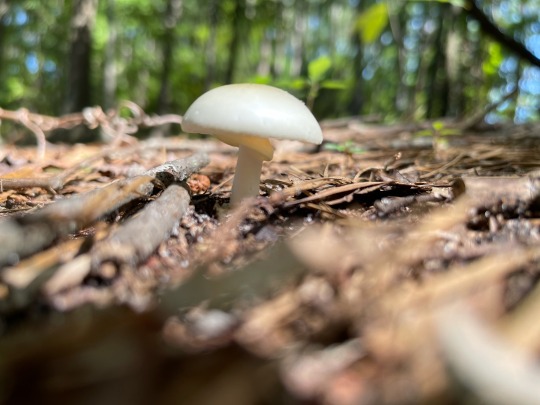
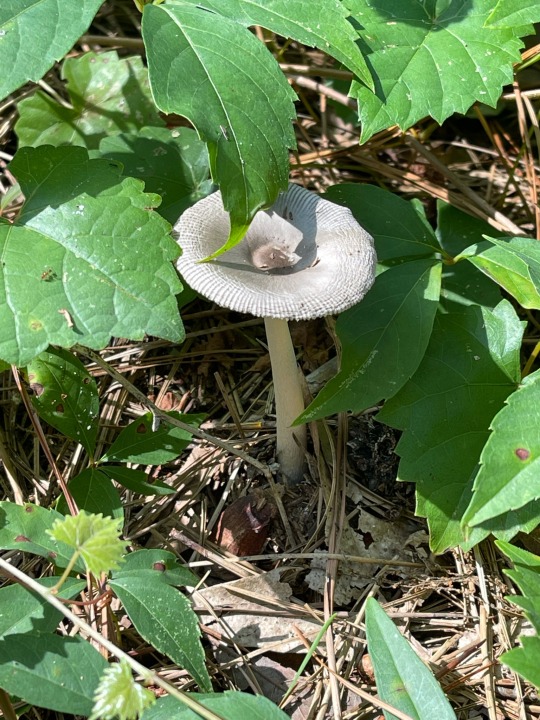
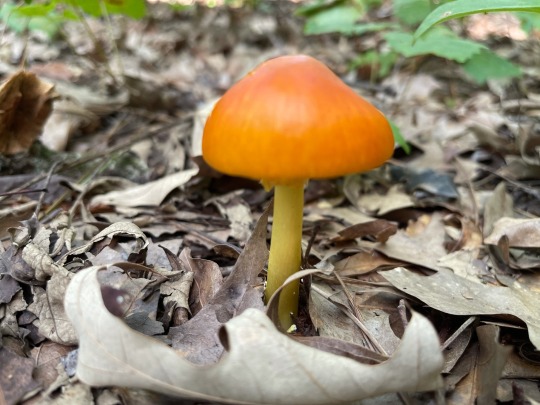
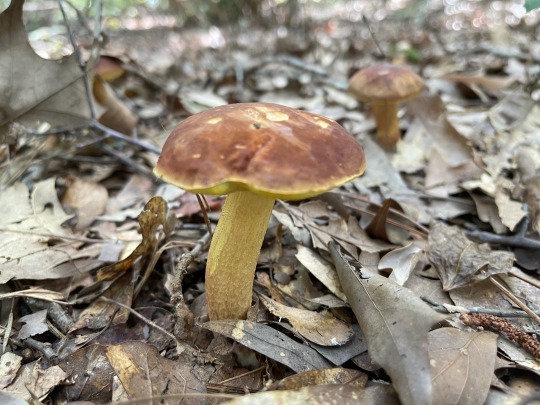
Mushrooms of the forest 🥺
#Marasmiaceae#Hygrophoraceae#waxgills#boletes#Boletaceae#mushrooms#mushroom#mushrooms of the forest#mushroom varieties#naturecore#forestcore#nature#cottagecore#witchcore#cottage aesthetic#cottage witch#botany#poisonous mushrooms#edible mushrooms#forest photography#forest aesthetic#forest hikes#nature hikes#nature trails#nature trail#beautiful nature#nature photography#forests#lush forests
2 notes
·
View notes
Text


two specimens of a Marasmius sp. likely Marasmius vagus
1 note
·
View note
Text
#1663 - Campanella gregaria - Gregarious Shells


An intriguing little mushroom that grows abundantly on the underside of rotting Banksia, Casuarina and Eucalyptus wood and bark.
The fruiting bodies are brown or grey, and rubbery, with radial ribs and a honeycomb of other partitions between those ribs.
There’s some 40 species of Campanella, mostly tropical, and a good range in the eastern parts of Australia, but C. gregaria seems most closely related to the NE Asian Campanella boninensis. But there is a second Campanella sp. in WA that has yet to be described. There’s also a genus of ciliates called Campanella, which is simply annoying.
8 notes
·
View notes
Photo
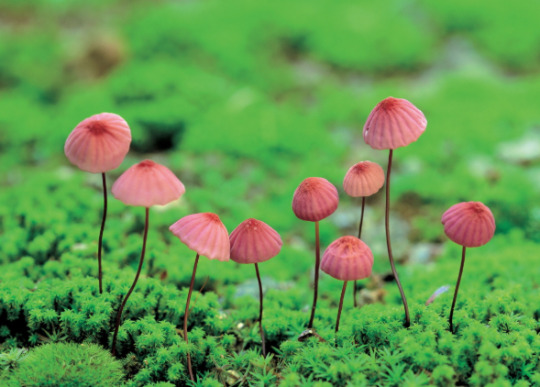
Marasmius pulcherripes
#fungi#mushrooms#mycology#basidiomycota#agaricomycetes#agaricales#marasmiaceae#marasmius#marasmius pulcherripes#pretty
222 notes
·
View notes
Text

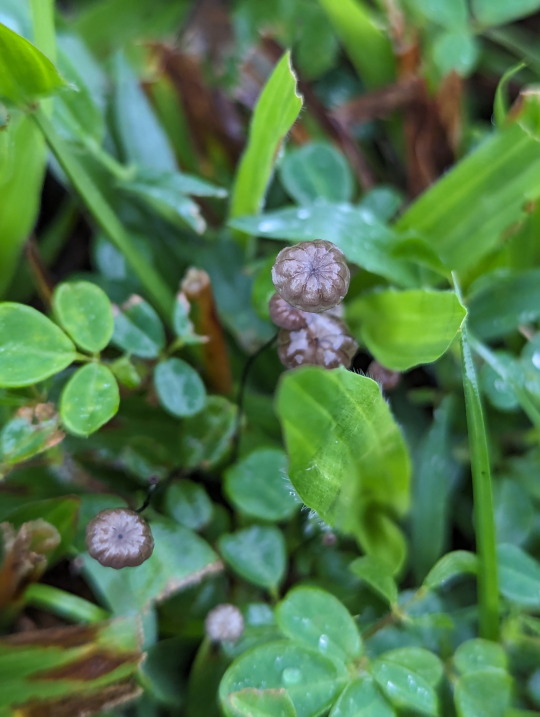
16/12/23 Photos 1-2 - Specimen 1

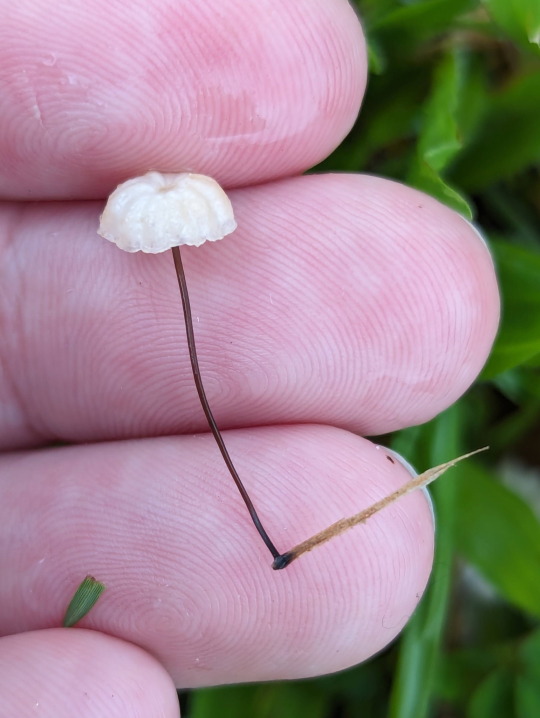
16/12/23 Photos 3-4 - Specimen 2


17/12/23 Photos 5-6 - Specimen 3

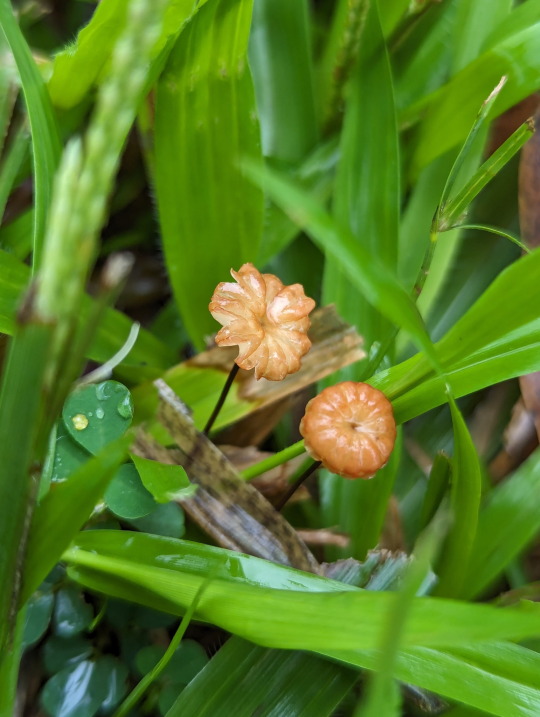
16/12/23 Photos 7-8 - Specimen 4


17/12/23 Photos 9-10 - Specimen 5
Marasmius mushrooms which sprouted after heavy rainfall.
These adorable mushrooms often resemble small parasols, with the side of the cap curving inward with the gills - the gills themselves arranged quite spatially. This gives the mushroom the shape of a small parachute, and with the stems often being thin and barely noticeable, their caps cover the garden in tiny little fairy parasols.
The specimens above were collected amongst the grass, though their small size makes them hard to spot. Looking forward for the rain's return during this heatwave to look for more mushrooms (though hopefully the flooding doesn't return).
Gills: branches found under the mushroom's cap
16-17/12/23 - Marasmius spp.
QLD:WET - Before/after Cyclone Jasper flooding
#fairycore#cottagecore#Marasmius#unidentified#Fungi#fungus#mycology#Marasmiaceae#pinwheels#Basidiomycota#Basidiomycete Fungi#Agaricales#mushrooms#shrooms#cute#nature
19 notes
·
View notes
Text


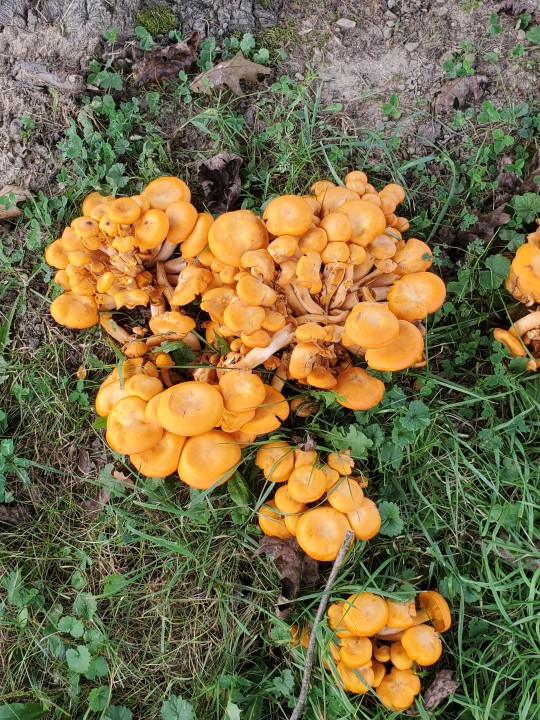
9/18/21
#jack-o'-lantern mushroom#mushroom#fungi#Omphalotus illudens#poison#basidiomycota#Agaricomycetes#Agaricales#Marasmiaceae
1 note
·
View note
Text
FOTD #128 : amazonian parachute! (marasmius amazonicus)
the amazonian parachute is an agaric fungus in the family marasmiaceae. there is little currently known about it, however it has numerous observations in south america !! they often occur on decaying leaves, & act as decomposers.
the big question : can i bite it??
it is currently unknown whether or not this fungus is edible.


m. amazonicus description :
"the amazonian parachute is a small mushroom with a brownish purple cap full of irregular pale yellow spots."
[images : source & source]
[fungus description : source]
#• fungus of the day !! •#[marasmius amazonicus]#: amazonian parachute :#128#||#fungus#mushrooms#mycology#nature#cottagecore#earth#foraging#forestcore#mushroom#fungi#fotd#fungus of the day#marasmius amazonicus#amazonian parachute
158 notes
·
View notes
Video
Blue mushroom, Clitocybula azurea? Marasmiaceae by Andreas Kay
Via Flickr:
from Ecuador: www.flickr.com/andreaskay/albums
3 notes
·
View notes
Photo

_Marasmius oreades_ #Marasmiaceae #Scotch_bonnet #fungi #シバフタケ 芝生に生えているキノコ、普通に見かけるけれど、あれは何? シバフタケ — あまりにも素直な名前なので、適当に答えているのかと誤解されがちだが、きちんと調べたうえで答えを出している。 (スターバックスコーヒー カインズホーム前橋吉岡店)
23 notes
·
View notes
Photo

Ghost fungus (Omphalotus nidiformis) in Australia
Ian Bool
271 notes
·
View notes
